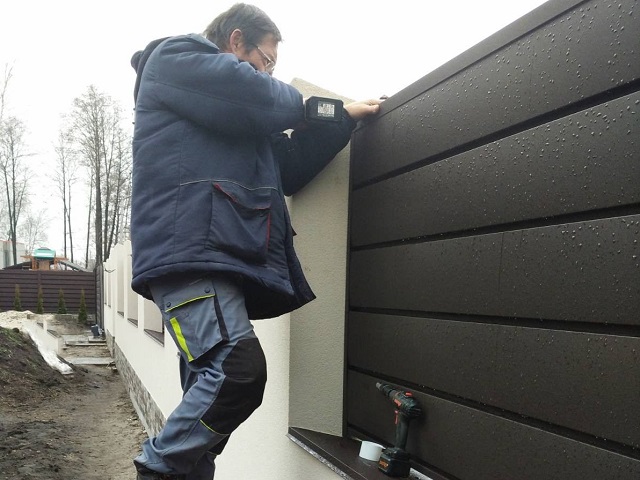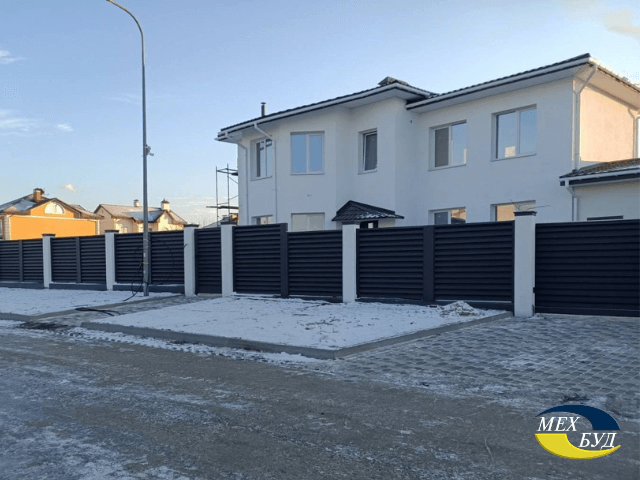With the onset of cold weather, the intensity of outdoor construction and installation work decreases. This decrease also affects the installation of fences, but some landowners are still forced to install fences during the cold season. Sometimes, this is due to the need to meet planned deadlines, but often it is dictated by necessity. In some cases, leaving the site without a fence for an extended period is simply not an option—otherwise, even with round-the-clock security, the construction site may be subject to theft.
On the whole, there’s nothing inherently wrong with this situation. However, to avoid disappointment, it is essential to choose the right fence design and consider the specifics of installation during the winter. There are quite a few nuances to consider, and we will discuss the most important ones in our article.
Main Challenges in Installing Fences in Winter Temperatures
From late autumn to early spring, we experience consistently low temperatures. While there have been frequent thaws lately, predicting them is quite challenging, and temperatures still drop below freezing at night.
In addition, it’s essential to consider not only the air temperature but also the ground temperature. A brief thaw after a week of intense frost doesn’t guarantee a quick thawing of the ground. Therefore, even in the first days of a thaw, one must work differently from the standard procedure, taking into account the temperature and structure of the deep layers of the soil.
So, what are the challenges when installing fences in such conditions?
- The first, quite evident problem, is frozen ground. When installing many fencing structures, especially heavy ones, there’s a need for earthworks—excavating the soil for trenches, small pits, and other depressions for the foundation preparation. If the ground is frozen due to severe frost, digging it up, even with specialized equipment, will be challenging. Manual work can only be done after preheating. The simplest method is to set up fires at the fence’s support post locations, and the warmth from these fires melts the ice. It’s an old-fashioned method, but it works!
Certainly, all these problems can be addressed if known in advance. The simplest way to solve them is to choose a fence for installation during the winter period that will be minimally affected by the cold.
Which constructions are undesirable to install in winter?
Let’s first analyze which fences should not be installed during winter:
- The first “candidate for elimination” is lightweight plastic fences. The main problem is that PVC becomes brittle at low temperatures. If the fence is already installed, it may not pose too many problems. However, installing a plastic fence in cold weather without damaging it is a very challenging task. Any fastening and any force pose a potential risk of cracking along stress lines. Also, as mentioned earlier, deformation is a concern, and gaps must be left for the plastic to expand. Guessing the correct gap size can be difficult, and there is a possibility that the gap will be very large, leaving a noticeable opening between the components in warmer seasons.
- The next type of construction that is unsuitable for winter installation is brick and stone fences. The reasons are clear: firstly, they require a massive foundation, and secondly, cement mortar is used for their construction. In negative temperatures, both factors strongly impede the installation for the reasons described earlier.
Fences suitable for installation in cold weather
So what can be installed in cold weather? Under such conditions, the installation includes:
- Panel fences as a temporary fencing structure. If you plan to install a stone, brick, or concrete fence, it’s indeed easier to wait for spring and temporarily enclose the area with panel fences for the winter. Such a structure does not require a permanent foundation, and temporary supports can be installed in small holes. Instead of using concrete, you can try filling the holes with stones—this will be sufficient for a few months, and it will be easier to dismantle the supports later. The main thing is that even the strongest frosts practically do not interfere with the process, as long as you can drill the ground.
- Mesh or lattice fences. These structures are quite lightweight, so the installation of support posts for them is not difficult. Again, you can set up temporary supports in winter and then, with the onset of favorable weather conditions, concrete the permanent frame. On the other hand, if you do not plan to make a monolithic strip foundation, you can also concrete the supports. Of course, you will need to spend on purchasing anti-freeze additives, but with the right approach, you can be confident in the reliability of the structure, and there will be no need to redo the fence.
How you see it, the main challenge that is relevant for almost any material is the installation of the fence foundation and the fixation of supports. If possible, all these works should be done in advance, before the onset of cold weather (or at least before the first stable frosts). In the future, you can then install lightweight structures on the already installed supports—this significantly reduces the complexity.
RECOMMENDATIONS FOR INSTALLING A FENCE IN COLD WEATHER
If you choose a panel metal variety for winter fence installation, problems with deformation in the cold and subsequent temperature increases will be irrelevant. This is because the design of modular sections includes technological clearances—thus, even significant changes in dimensions (within millimeters) will be imperceptible and will not affect the strength. The fence will remain neat and quite reliable—gaps will not be visible and certainly will not reduce the strength of the structure.
Note! This is only true if the fence was measured, designed, and manufactured correctly. Therefore, it is advisable to entrust the development of project documentation to qualified specialists (they will take into account the need for technological clearances). Additionally, it is essential to order fence components from reputable companies that ensure the maximum accuracy of section manufacturing. The reason for this is the heightened quality requirements for the metal: as mentioned earlier, the peeling of the polymer coating from cheap Chinese steel often becomes a problem.
Also, consider the following:
- Supports for fence installation can be placed in holes drilled in the ground. To facilitate work with frozen soil, you can use earth augers—this will reduce the time for preparing holes. Preheating the soil (even just under a layer of polyethylene film) will reduce the tool’s load and speed up the work. Manual drilling is also possible, but in this case, the soil needs to be heated as efficiently as possible, or there is a risk of the tool getting stuck.
- When concreting support posts, it is desirable to use mixtures with additives that increase their frost resistance. It is also advisable to cover the base of the support before the complete polymerization of the concrete and the gain of its strength—this way, the damage from low temperatures will be minimal. You can cover it with polyethylene, non-woven material, tarpaulin, etc. In general, any material with thermal insulation characteristics will work—down to sawdust and straw.
TO INSTALL YOURSELF OR TURN TO PROFESSIONALS?
If you have experience installing fences and have an adequate number of helpers, you can install a simple fence with a short length even in winter—albeit not in the coldest temperatures. However, there are more arguments in favor of entrusting winter fence installation to professionals:
- They can take into account the features of the terrain and soil on the site and adjust the foundation design.
- Experience in winter work allows them to mitigate the negative impact of low temperatures on concrete and soil by taking preventive measures.
- The installation will be done more quickly, allowing you to meet the deadlines for construction or restoration projects.
There is a pragmatic advantage as well. In the winter, there are relatively few orders for the installation of fencing structures. Therefore, you won’t have to wait long for a team of specialists to become available. Moreover, the work itself is usually done with higher quality, as professionals in such conditions usually don’t need to rush to the next project. So, time savings and an additional guarantee of quality will also be a plus.
CONCLUSION
As you can see, fences can be installed even in winter, especially when all the nuances are considered in advance and the right design is chosen.
Preparation, the use of anti-freeze additives for concrete, and a professional approach to design and installation are the key conditions for the successful implementation of such a project. Naturally, it is advisable to entrust the task to professionals—after all, the complexity of winter installation is quite high for independent work.



